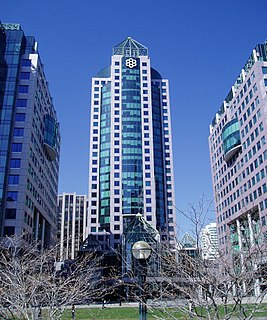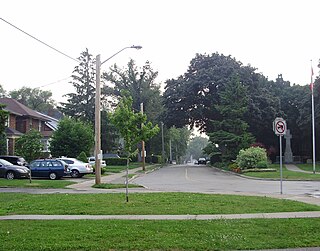Related Research Articles

The Municipality of Metropolitan Toronto was an upper tier level of municipal government in Ontario, Canada, from 1954 to 1998. It was made up of the old city of Toronto and numerous townships, towns and villages that surrounded Toronto, which were starting to urbanize rapidly after World War II. It was commonly referred to as "Metro Toronto" or "Metro".

North York is one of the six administrative districts of Toronto, Ontario, Canada. It is located directly north of York, Old Toronto and East York, between Etobicoke to the west and Scarborough to the east. As of the 2016 Census, it had a population of 869,401. It was first created as a township in 1922 out of the northern part of the former township of York, a municipality that was located along the western border of Old Toronto. Following its inclusion in Metropolitan Toronto in 1954, it was one of the fastest-growing parts of the region due to its proximity to Old Toronto. It was declared a borough in 1967, and later became a city in 1979, attracting high-density residences, rapid transit, and a number of corporate headquarters in North York City Centre, its central business district. In 1998, North York was amalgamated with the rest of Metropolitan Toronto to form the new city of Toronto and has since been a secondary economic hub of the city outside Downtown Toronto.

Mimico is a neighbourhood and a former municipality in Toronto, Ontario, Canada, being located in the south-west area of Toronto on Lake Ontario. It is in the south-east corner of the former Township of Etobicoke, and was an independent municipality from 1911 to 1967.
William Donald Dennison was a Canadian social-democratic politician that served in both the Ontario Legislative Assembly and finally as the City of Toronto's mayor. He served two nonconsecutive terms as a Member of Provincial Parliament (MPP) in the 1940s and early 1950s. After his provincial-level career, he focused on Toronto's municipal politics, holding offices as an alderman, member of the Toronto Board of Control, and finally as the city's mayor. He was the mayor from 1967 to 1972, winning two consecutive three-year terms. Prior to entering politics, he was a school principal and teacher. As of 2020 he was the last mayor of Toronto to be a member of the Orange Order.
Alan Tonks is a former Canadian politician. He was the Liberal MP for the federal riding of York South—Weston in Toronto from 2000 to 2011, and was the final Metro Toronto Chairman before the amalgamation of Metro Toronto into the new City of Toronto.
Morley Kells is a former politician in Ontario, Canada. He was a Progressive Conservative member of the Legislative Assembly of Ontario on two separate occasions from 1981 to 1985 and again from 1995 to 2003, and was briefly a cabinet minister in the government of Frank Miller. He was an unsuccessful candidate for Toronto City Council in the 2010 municipal election.
Ruth Anna Grier is a former politician in Ontario, Canada. She was a New Democratic Party member of the Legislative Assembly of Ontario from 1985 to 1995, and served as a high-profile cabinet minister in the government of Bob Rae.
Christopher Dennis Flynn O.Ont, was Chairman of Metropolitan Toronto from 1984 to 1988. Flynn rarely used his first name and was commonly known as Dennis Flynn.

The Chairman of the Municipality of Metropolitan Toronto or Metro Chairman was the regional chair of Metropolitan Toronto, Ontario, Canada, and the most senior political figure in the municipality. The Metro Chairman was elected by the members of Metropolitan Toronto Council.
Bruce G. Sinclair is a former politician in Toronto, Ontario. He was mayor of Etobicoke from 1984 to 1993, when he was defeated by Doug Holyday. Before becoming mayor, he served 15 years on Etobicoke's council as alderman and controller. From 1998 to 2000 he was a member of Toronto City Council, but was defeated in the 2000 Toronto municipal election.

Long Branch is a neighbourhood and former municipality in the south-west of Toronto, Ontario, Canada. It is located in the south-western corner of the former Township of Etobicoke on the shore of Lake Ontario. The Village of Long Branch was a partially independent municipality from 1930 to 1967. Long Branch is located within a land grant from the government to Colonel Samuel Smith in the late 18th century. After Smith's death, a small portion of it was developed as a summer resort in the late 1800s.
Municipal elections were held in Toronto, Ontario, Canada, on December 5, 1966. The elections were the first in Toronto after its merger with several smaller suburban communities on January 1, 1967. Forest Hill and Swansea were annexed by the City of Toronto, Leaside was merged with the Township of East York to become the Borough of East York. Weston was combined with the Township of York to form the Borough of York. The Village of Long Branch and the towns of Mimico and New Toronto were merged with the Township of Etobicoke to form the Borough of Etobicoke.
The Board of Control of Toronto, Ontario, Canada, was a part of its municipal government until it was abolished in 1969. It served as the executive committee of the Toronto City Council. When it was initially created in 1896 by mandate of the provincial government, it consisted of three Controllers appointed from and by the aldermen, and presided over by the Mayor of Toronto. Beginning in 1904, the Board of Control was directly elected by the city's electorate and consisted of four Controllers, presided over by the Mayor. Each voter could vote for up to four candidates, and the four with the most votes were elected. By tradition the controller who received the most votes would get the powerful budget chief position.

Christine Hogarth is a Canadian politician, who was elected to the Legislative Assembly of Ontario in the 2018 provincial election. She represents the electoral district of Etobicoke—Lakeshore as a member of the Progressive Conservative Party, for which she previously served as Ontario executive director.
Henry Oscar (Ozzie) Waffle was a Canadian politician who was reeve of Etobicoke, Ontario from 1957 to 1962. While reeve he advocated for the construction of monorails and was accused of conflict of interest after the city purchased dump trucks from his dealership. In 1973 he filed a lawsuit alleging Dennis Flynn could not be elected mayor of Etobicoke because he worked for the city of Toronto, causing a new election to be held. He died in 1980.
References
- ↑ "SEEK $100,000 FOR REFUGEES", The Globe and Mail, 19 Oct 1938: 15. via ProQuest
- ↑ "Administrative Changes", The Globe and Mail, 18 Jan 1939: 7 via ProQuest
- ↑ "CROSS DEMANDS TIGHTER CHECK ON RELIEF: Many in Larger Cities Get Undeserved Aid, Suspicion of Minister, One of First Centres to Face Inquiry Reported to Be Toronto, Where Cost Regarded 'Out of Line'; May Be Given Chance to Increase Its Inspection Staff Before Government Acts E. A. HORTON NAMED NEW RELIEF DIRECTOR", The Globe and Mail, 18 Jan 1939: 13. via ProQuest
- ↑ "E. A. Horton Resigns Post In Ontario Government", The Globe and Mail, 28 May 1941 via ProQuest
- ↑ "Political foes begin long climbs toward juicy borough plums", Wills, Terrance. The Globe and Mail, 19 Sep 1966: 5. via ProQuest
- ↑ "Suburban Elections", The Globe and Mail, 15 Dec 1952: 8. via ProQuest
- ↑ "Suburbs Vote Light, Few Changes Result", The Globe and Mail, 7 Dec 1953: 1 via ProQuest
- ↑ "Metro in profile No 1: Etobicoke 'A place where everybody should want to live...'" by Robertson Cochrane, Toronto Daily Star, 14 November 1966, pg 7 via ProQuest
- ↑ "Merger paradox: Fewer councils but races for top make room below", Wills, Terrance. The Globe and Mail, 3 Oct 1966: 5 via ProQuest
- ↑ "E.A. Horton, ex-Etobicoke mayor", Toronto Star,29 Mar 1980: B8 via ProQuest
- ↑ "Etobicoke's mayor undecided on third term: Meeter and greeter but no political mover", Russell, George. The Globe and Mail,29 Aug 1972: 5. via ProQuest
- ↑ "Flynn gets Etobicoke's top job", Toronto Star 5 Dec 1972: 1. via ProQuest
- ↑ "Three enter when Mayor Horton leaves:, Appel, Suzanne. The Globe and Mail, 13 Nov 1972: 4. via ProQuest
- ↑ "AFTER A FASHION: Heartfelt help for former mayor" Cherry, Zena, The Globe and Mail, July 11, 1977, pg. 12 via ProQuest